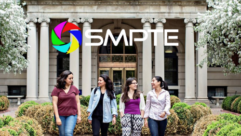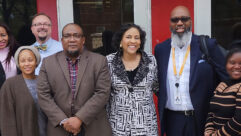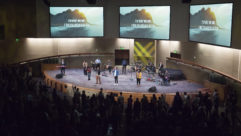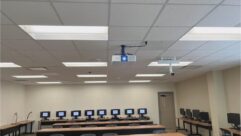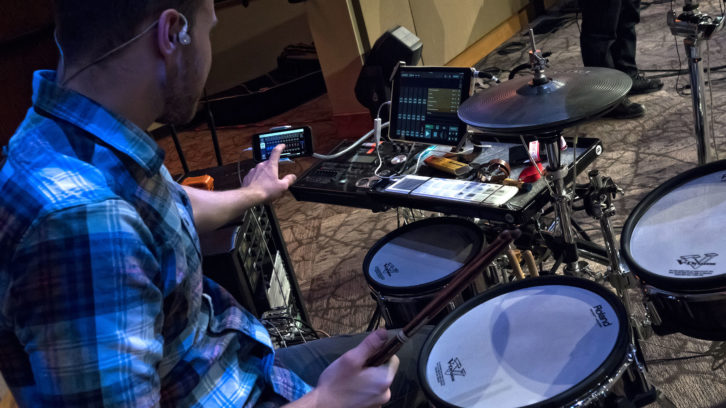
On this edition of the SVC Podcast, Contributing Editor Bennett Liles talks with Roland Dutzmann of AcousTech and Nate Carter AVL engineer at Charis Bible College about outfitting The Auditorium, the institution’s new 3200-seat worship, performance and teaching space. The stage monitoring is based on KLANG:vier immersive IEM mixing systems. Roland and Nate discuss the stage monitoring RF transmission, the front of house mixer and amp/speaker system design.
FOR MORE: GO TO PART 2
Links:
- AcousTech – audio, video and lighting in Franktown, Colorado
- Charis Bible College in Woodland Park, Colorado
- Klang:vier supporting individual 3D monitoring mixes
- Shure PSM 900 IEM transmission system
- RedNet AM2 PoE based stereo analogue output device for DANTE signals
Transcript-
The Auditorium, a huge new 3200-seat worship and teaching space at Colorado’s Charis Bible College, had to be completely outfitted for sound, video and lighting. They called in local AVL contractor AcousTech. Charis AVL engineer Nate Carter and AcousTech’s Roland Dutzmann are here to give us the story coming up on the SVC Podcast.
Roland and Nate, it’s good to have you with us on the SVC Podcast coming to us from Charis Bible College in Woodland Park, Colorado. Long way from us in Atlanta so it’s nice to have this kind of connection quality.
Nate: Modern technology. [Laughter]
Tell me Nate, about the Charis Bible College and their plan for The Auditorium. This was a complete, right from the beginning, brand new facility.
Nate: That’s an interesting question. Because of the timeframe that these building projects happened over – and this really kind of ripples through and affects every aspect of this install, there were redesigns even during the process of building the building because it was built over a four-year period. So quite literally, as the building was getting built the plan for that performance base was evolving. So it presented some design challenges and just things we had to move around and figure out as we were installing aspects of the video lighting system in phases. So it was an interesting challenge. It just drew quite a lot of flexibility. [Timestamp: 1:38]
Yes, over that long period there was time for the technology itself to march on.
Roland: Yes, indeed. And the construction took four years.
Nate: Yeah.
Roland: It actually was started working on design even on the auditorium phase more than eight years ago. So it went through a lot of morphing for sure. [Timestamp: 1:58]
So plenty of time to catch up to whatever is out there that may have been new or not even around yet when you first started the planning.
Nate: Yeah, a few aspects of that, yes.
Roland: That’s right.
And you two have worked together for a while now. Roland, tell me, how long have Charis Bible College worked with AcousTech? You guys go back a pretty good way don’t you?
Roland: Yes. It was either the fall of 2010 or 2011 we were contracted on to work on the design for this whole facility, which ended up being done in two phases so far. Phase I, which is called “The Barn,” but is actually a 1,100-seat full performance space that can be set up for whatever conferences, dinners, whatever it might be, with full sound, lighting and video. And then that was completed like January of 2014. And then shortly after that they already began construction on the auditorium, which didn’t complete until fall of 2018. And some aspects were still under construction this year, like a parking garage, etc. So we’ve been on it for quite a long time. And then Nate and I actually met right about at the opening of The Barn in late 2013 or early 2014.
Nate: Yeah. I started in this department originally as a volunteer and I had come from a large – about 1,000-1,500 person church in Texas. I came here without any intention – not for a job or anything like that, but it just – we got connected here and just kind of got connected to the vision and eventually that led to a full-time job. But I literally met Roland as he was kind of mixing and commissioning and setting up for the first time. We had gotten in The Barn just in time for rehearsals basically the Saturday before we were going to be in there for school on Monday. So it’s –
Roland: [Laughs] Fun.
Nate: Yeah it’s lots – [Laughs] it was fun, but you know, it’s always that mild breaking of sweat as you’re getting every last thing in place. We don’t really like to do that, but that’s kind of ended up being the case with Charis Bible College in some arenas is because we’ve really, just for the last almost eight years but more closer to probably six years, we’ve been in an unprecedented time of growth and expansion. So we’ve just done and built so much in such a short time it just tends to happen that way sometimes. [Timestamp: 4:33]
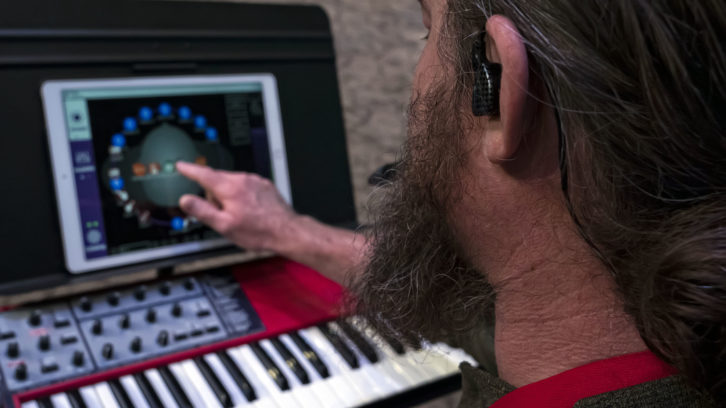
You’ve been at it a good while. Tell me what is the general design and layout of the main house sound system as far as speakers, amps, location of rack gear and that kind of thing?
Roland: There’s a very large – I’m going to call it an electrical room, but it’s electrical, it’s storage, it’s an audio rack room. It’s got its own AC system, of course, to keep things cool. The main speaker system in the auditorium are three hangs of 10 NEXO S12 boxes, S1230’s on the bottom and then nine S1210’s – so three line array hangs of those. And then two hangs of four NEXO RS18 cardioid subs for each two hangs. And all of that is powered by the NEXO NXAMP 4×4 power amplifiers; four by 4,000 watts. Then we have some balcony fills that are actually JBL single sight small boxes for under-balcony fill. And up at the very top of the balcony, which wasn’t originally there [Laughs] when we designed the NEXO system –
Nate: Part of the redesign the whole balcony extended out.
Roland: Part of the redesign, the balcony got deeper and taller. And because of height limitations and some sight line issues we actually put six EAW MK396 2-way boxes for the very upper back balcony fill just to replace a little bit of the spectrum and level its loss from the line arrays. [Timestamp: 6:18]
OK and you selected, I believe it was a Yamaha CL5 for the front of house mixer?
Roland: That’s right.
And where do you have that?
Roland: Front center of balcony is audio and video control booth. Now what’s done from there is obviously front of house mixing and lighting system operation and the iMac operator for presentation stuff to the screens.
Nate: Yeah, in-house graphics. [Timestamp: 6:45]
OK so you have all of the tech guys right there shoulder to shoulder working together.
Roland: That’s right. All the switching and all of their control of their camera systems, etc., there’s actually a completely independent control room for all video production for streaming, recording everything. And right night next to it in its own little isolated room where we are sitting is the multitrack audio room, which is audio for video.
Nate: Our broadcast mix, yeah.
Roland: With a CL5 also. [Timestamp: 7:17]
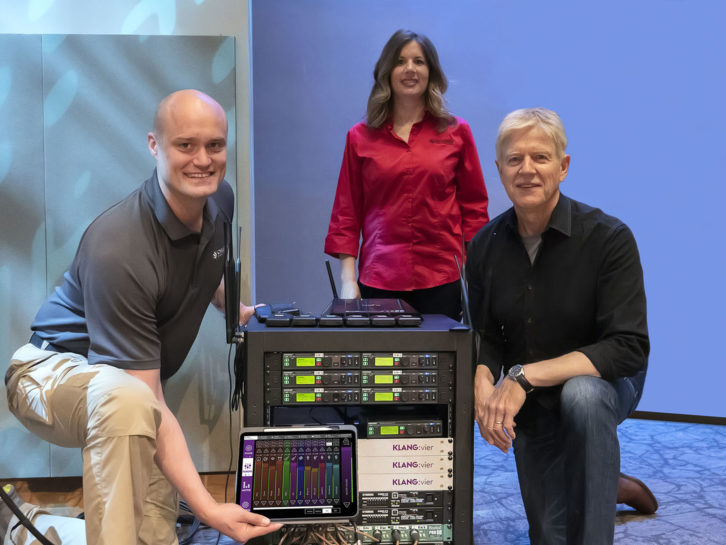
And one of the major things we have seen on the press release for this is the Klang:vier system for stage monitoring. What are the advantages you have with that?
Nate: I’ve been pretty much involved on the musician side with live sound since I was late elementary school, so I’ve been involved in tons of praise and worship setups. I’ve been on Avioms, I’ve been on monitor mixing console and having that feed. The thing I really liked about the Vier after I kind of tested the demo, it was the first thing I’ve ever been on that felt like natural sound in a room. All the way through junior high and high school I played in an orchestra. I was a violinist. And so I’m used to hearing all of this instrumentation and listening through mixes of things in an open space. And then you go from there and whether it’s an Aviom system or it’s just a stereo pair out of a monitor console, everything is very flat and for me it feels unnatural. The beautiful thing about the Vier, I feel it’s like the first thing in the market that really lets your brain relax. It makes it very easy and intuitive to monitor in a space, whether that space is in a large performance hall in a studio, you get lots of options with the Vier system. And the audio quality is impeccable. The other aspect, that just as a technical aspect, I like the fact that it can integrate with virtually anything. It will do Dante, it will take ADAT in. The larger unit will even take in some analog input. So it not only can operate as IO, converting ADAT and light pipe, whatever you want to call it, into your Dante network, it gives you so much versatility for how you’re going to work with your in-ears. That coupled with just the stellar audio quality and the natural sound stage it was just a no-brainer.
Roland: Yeah. Creating that sound stage in your head is really the big deal. Instead of just having two dimensions of left/right, having front/back added to that, it’s a whole new world.
Nate: So up until we used the Klang unit, even in the older performance area, we used an Aviom implementation because we don’t normally staff or plan in such a way to have a dedicated monitor mixer and musicians generally like to just adjust their own mixes and save the presets and things like that. When they moved from an Aviom system and they started using and listening to Klang for the first time, you would have thought they were seeing for the first time. It was a massive thing. And now they like it so much they’re starting to try and utilize both the barn and the auditorium simultaneously for things and all the musicians are lobbying really, really, really hard to be playing –
Roland: In the auditorium. [Laughs]
Nate: Yeah. Well, to be – either A, do everything in the auditorium or we have a proposal right now that it will move forward at some point in the year that we’re going to bring a Klang system into the previous performance space because there really isn’t a comparison at this point. [Timestamp: 10:26]
And so how do you get the signal actually into the musicians’ ears, the IEM transmitters and receivers?
Nate: So with the CL5’s in the auditorium setup, we have a primary and secondary Dante network. All of the Viers live on the primary, secondary and then the analog outputs from those Viers go to a couple of rack spaces of Shure PSM900’s. And then each musician has whatever in-ear monitors they purchase for themselves usually.
Roland: And some of the players are wired, but by wired it’s a CAT cable to a Dante headphone amp sitting on a mic stand right by them and they just plug in.
Nate: We use implements – some RedNet. They get power over Ethernet. It’s super easy. So we basically just in the design of the stage, Roland kind of distributed just some CAT5 –
Roland: And some CAT jacks for plug-in.
Nate: Yeah. Go back – yeah. And really all you have to do in a Dante network is just go back to PoE switch. And so it’s a single cable. It will power the RedNet AM2, and then people just plug their headphones directly into there. Because it was decided to go with that Dante backbone, routing, connecting anything virtually is – it’s really very simple. [Timestamp: 11:38]
Yeah, I was going to ask how the learning curve was on that and how everybody kind of got used to it.
Roland: Well thankfully most of those people don’t patch the Dante.
Nate: No, they don’t. Yeah.
Roland: Charis has always had an interesting in the technology. For the gentleman that was running the technical department back when we did Phase I, he was a big upgrade for the organization. And then Nate, and actually his wife Katie, really took over that position and they have taken it to a whole new level. They are very technical and very adept, so a lot of that kind of stuff. They’ve got the expertise in Nate and he’s got some other people that have been trained under him. So they’re really good at keeping those things ready. The musician don’t really have to get into that. They just need to kind of know how to play with their mix, etc.
Nate: that learning curve has been the Klang interface on personal mobile devices.
Roland: On their phone, iPad. [Timestamp: 12:33]
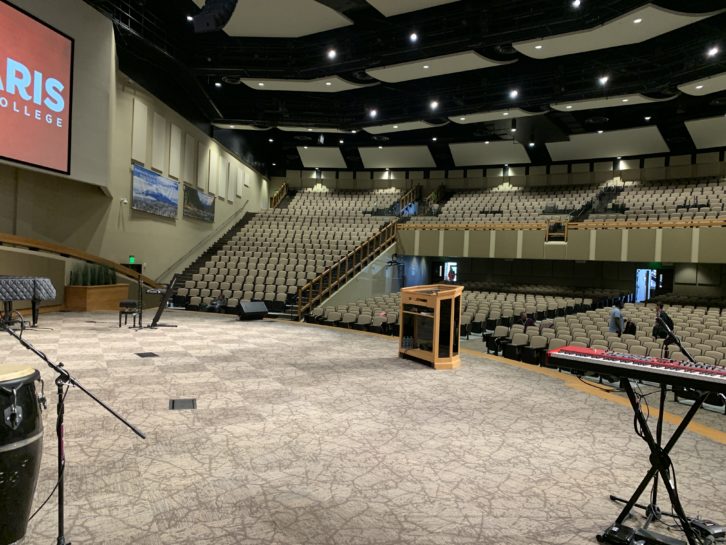
And they already know how to work those so it pretty simple for them to get into.
Nate: We are a school so every three years we have like a whole new batch of volunteer musicians. So that learning curve, sometimes it’s the first time they have ever used an in-ear monitor setup ever. But for the people who kind of live here and run that department, they basically felt like they got it in about two weeks. Like you can go as deep as you want to, really, with Klang. You have the ability to EQ within your own mix or within the system itself, just your channel. So you can be adjusting some simplified preset EQ’s across channels in your mix. Not everybody goes that deep, but at least the people who that’s very beneficial to, they have the option for that. So it was a good thing. [Timestamp: 13:23]
So how was it getting all of that in? Did you have to get in between events and things to get all the stuff installed?
Roland: Well that’s when this building was first opened and started running. So we had a little more time this time around than on phase one. Another good thing about having such a good technical person on staff here, when we did the first audio run-through with a band and singers and everything, I was up at front of house and Nate was down there mixing everybody’s Klang systems to get them going and he did an awesome job. You can imagine you have 15 singers and players and everybody’s trying to figure out what they’re doing. He actually got them up and running, then they could tweak from there. That’s where it started. Now, of course, they’re all more adept at handling that themselves.
Nate: And even in the auditorium we got into that room to configure about a week and a half before school started – again. [Laughter]
Roland: Hey, but that’s a week and a half.
Nate: It was a week and a half. That’s much better than –
Roland: Two days.
Nate: Knocking everything in in two days. But after we basically kind of have got everybody comfortable with the control system, essentially everybody, they just jump in, do their mix, save their own personal preset on device and then they can just walk in on any day. Pretty much no matter what has happened in the days preceding – because that room gets used for all sorts of things all the time. They just walk in and they can recall their personal mix settings and boom, they’re ready to go. [Timestamp: 14:55]
When something happens, what do you have to do to get that whole place ready for a major performance event say, testing everything so you know it’s all working?
Nate: We’re a department that’s very big on creating SOPs, standard operating procedures. Because of the versatility of things that have come to live in that room we have to create SOPs because oftentimes we’ll do a conference and then on one given day of that conference they’ll do a performance, which means the LED wall comes in, gets built overnight, gets tested. Video gets reconfigured. Recall is seen on the CL5 to run like 12 actor mics at a time. I mean we’ve got 22 hooked up and going, but we could not do what we do without creating the flexibility and infrastructure that the CL5 consoles coupled with the Dante network coupled with Klang coupled with all of the video routing. So the way we tend to do things would not be possible prior to this digital age as in a way of saying that. But we can turn the whole building over in about six to eight hours if need be. For performances we use essentially a 13×40-foot LED wall, 22 headset mics and then the whole graphics and playback scenario. That whole thing, we repatch that. With our setup we basically do a lot of the engineering before the event happens so when we go into it we have a plan. We basically just pull it apart, put it into the configuration that we’ve already kind of designed and then as soon as it’s done we pull it apart and put it back, run through line check signal tests. So yeah, we can basically –
Roland: Go back to a worship band and speakers.
Nate: Yeah, straight form a theatrical performance with 85 cast members and stuff like that. [Timestamp: 16:57]
That’s great having a plan in place so all you have to do is knock down the first domino and hopefully have everything just fall into place.
Nate: Ideally, yeah.
Well, I know you have a lot going on there and we sure appreciate your taking time out to do this. In Part 2 we’ll get into lighting, communication and mics. We’ve been talking to Roland Dutzmann of AcousTech and Nate Carter, Charis Bible College AVL engineer coming to us from Woodland Park, Colorado. Really enjoyed hearing about it.
Roland: Thank you. Our pleasure.
Nate: Yeah. Nice to speak with you.
So now, with Klang immersive monitoring systems onstage and the Yamaha CL5 at front of house, Charis Bible College has The Auditorium ready to go for worship, teaching and other events. Next week Nate and Roland will give us the rest of the story on mics, intercom and lighting. Get with us for that on the next SVC Podcast.


